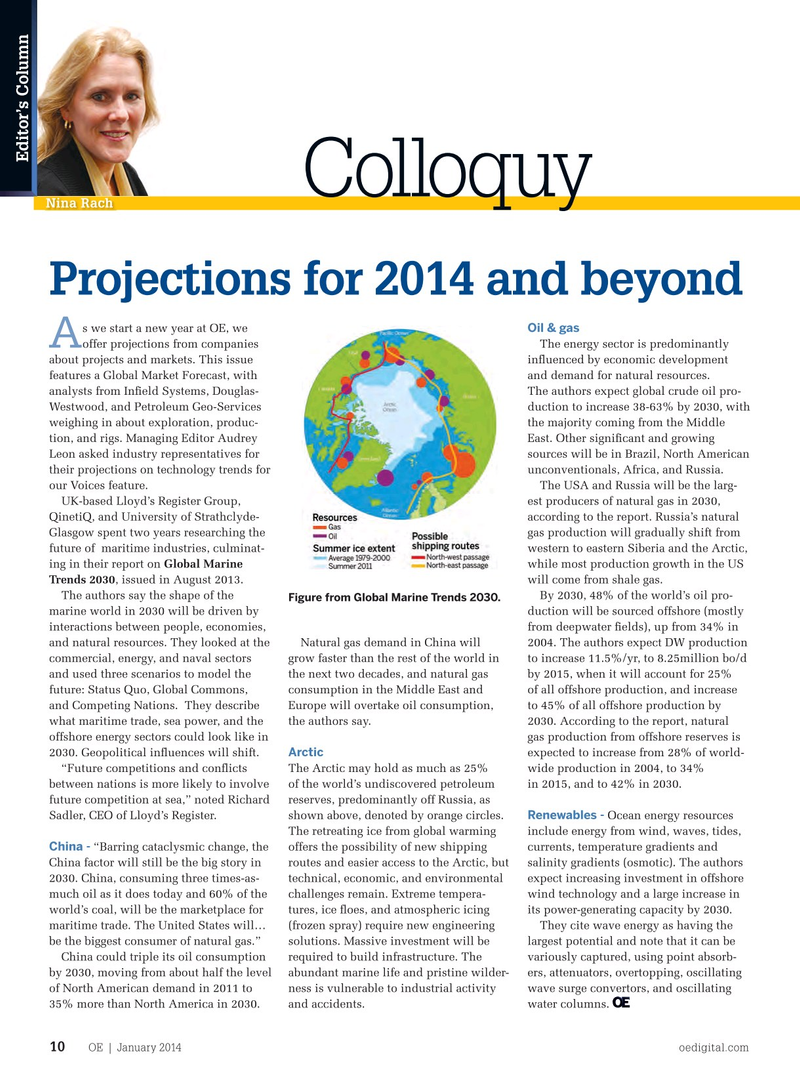
Page 8: of Offshore Engineer Magazine (Jan/Feb 2014)
Read this page in Pdf, Flash or Html5 edition of Jan/Feb 2014 Offshore Engineer Magazine
Editor’s Column
Colloquy
Nina Rach
Projections for 2014 and beyond
Oil & gas s we start a new year at OE, we
A offer projections from companies The energy sector is predominantly about projects and markets. This issue in? uenced by economic development features a Global Market Forecast, with and demand for natural resources. analysts from In? eld Systems, Douglas- The authors expect global crude oil pro-
Westwood, and Petroleum Geo-Services duction to increase 38-63% by 2030, with weighing in about exploration, produc- the majority coming from the Middle tion, and rigs. Managing Editor Audrey East. Other signi? cant and growing
Leon asked industry representatives for sources will be in Brazil, North American their projections on technology trends for unconventionals, Africa, and Russia.
our Voices feature. The USA and Russia will be the larg-
UK-based Lloyd’s Register Group, est producers of natural gas in 2030,
QinetiQ, and University of Strathclyde- according to the report. Russia’s natural
Glasgow spent two years researching the gas production will gradually shift from future of maritime industries, culminat- western to eastern Siberia and the Arctic, ing in their report on Global Marine while most production growth in the US
Trends 2030, issued in August 2013. will come from shale gas.
The authors say the shape of the By 2030, 48% of the world’s oil pro-
Figure from Global Marine Trends 2030.
marine world in 2030 will be driven by duction will be sourced offshore (mostly interactions between people, economies, from deepwater ? elds), up from 34% in and natural resources. They looked at the Natural gas demand in China will 2004. The authors expect DW production commercial, energy, and naval sectors grow faster than the rest of the world in to increase 11.5%/yr, to 8.25million bo/d and used three scenarios to model the the next two decades, and natural gas by 2015, when it will account for 25% future: Status Quo, Global Commons, consumption in the Middle East and of all offshore production, and increase and Competing Nations. They describe Europe will overtake oil consumption, to 45% of all offshore production by what maritime trade, sea power, and the the authors say. 2030. According to the report, natural offshore energy sectors could look like in gas production from offshore reserves is
Arctic 2030. Geopolitical in? uences will shift. expected to increase from 28% of world- “Future competitions and con? icts The Arctic may hold as much as 25% wide production in 2004, to 34% between nations is more likely to involve of the world’s undiscovered petroleum in 2015, and to 42% in 2030.
future competition at sea,” noted Richard reserves, predominantly off Russia, as
Renewables -
Sadler, CEO of Lloyd’s Register. shown above, denoted by orange circles. Ocean energy resources
The retreating ice from global warming include energy from wind, waves, tides, “Barring cataclysmic change, the offers the possibility of new shipping currents, temperature gradients and
China -
China factor will still be the big story in routes and easier access to the Arctic, but salinity gradients (osmotic). The authors 2030. China, consuming three times-as- technical, economic, and environmental expect increasing investment in offshore much oil as it does today and 60% of the challenges remain. Extreme tempera- wind technology and a large increase in world’s coal, will be the marketplace for tures, ice ? oes, and atmospheric icing its power-generating capacity by 2030.
maritime trade. The United States will… (frozen spray) require new engineering They cite wave energy as having the be the biggest consumer of natural gas.” solutions. Massive investment will be largest potential and note that it can be
China could triple its oil consumption required to build infrastructure. The variously captured, using point absorb- by 2030, moving from about half the level abundant marine life and pristine wilder- ers, attenuators, overtopping, oscillating of North American demand in 2011 to ness is vulnerable to industrial activity wave surge convertors, and oscillating 35% more than North America in 2030. and accidents. water columns.
OE | January 2014 oedigital.com 10 000_OE0114_Colloquy.indd 10 12/19/13 5:38 PM

 7
7

 9
9